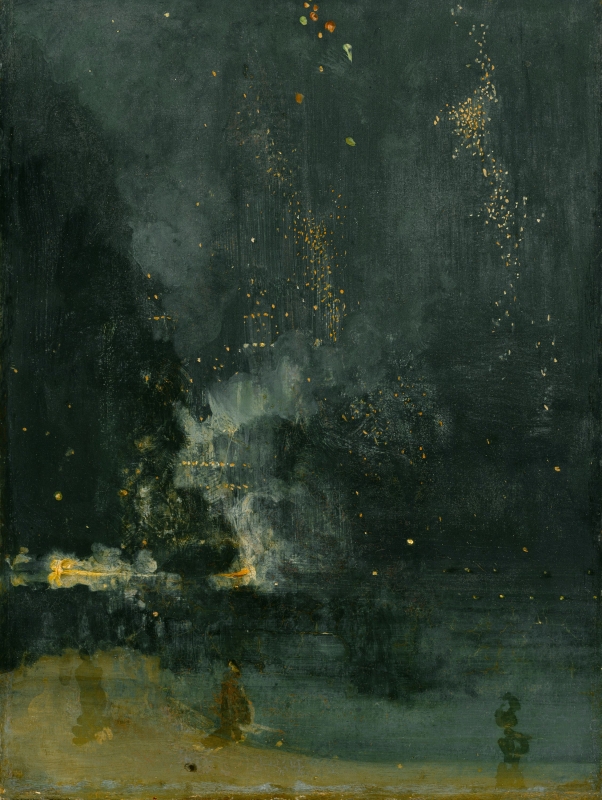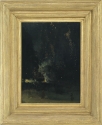Technique
Nocturne in Black and Gold: The Falling Rocket is painted thinly on a reddish brown base. The brushwork varies. Whistler used square brushes at the top, 7-14 mm (¼-5/8") wide; and much finer brushes to apply the vivid drops of orange and green fireworks (each separate fleck of colour applied individually), and the intricate diagonal shading around the showers of sparks. The dark water of the pool in the foreground was painted round the figure standing with one leg raised on the low wall around the pool. The only colour in this figure is the paint of the background.
In reproductions of Nocturne in Black and Gold: The Falling Rocket from 1892 to 1905 this figure cannot be seen, the two other figures in the foreground are barely visible, and the whole foreground is considerably simplified. Since the rest of the painting appears to have had much the same tonality as now (or perhaps to have been slightly lighter) darkening varnish in these early years cannot alone be held responsible. It therefore seems possible that it was Whistler himself who reworked the picture before October 1892, attempting to remove the foreground figures, which have a certain appeal and importance comparable to that of the elegant figures in Cremorne Gardens, No. 2 [YMSM 164].
In April 1892 Walter Richard Sickert (1860-1942) found the painting without any technical problems: he remarked on 'the exquisite enamel of "The Falling Rocket" … perfect form, exquisite colour, and that peculiar triumph of execution which consists in the complete absence of all appearance of labour. It has no more technique than the night sky itself, or the scattering sparks, or the cold, dark grass.' 1
Conservation History
Curiously, Richardson remarked in 1954 that 'An admirable photograph had been made at the time of its exhibition at the Goupil Gallery … in 1892; and when the panel was cleaned [in 1954], the delicate mists and sparkles of pigment showed scarcely any change from the state recorded there.' 2 This does not seem to be accurate. In fact Nocturne in Black and Gold: The Falling Rocket showed more detail in the foreground in 1954 than it did in 1892.
See 'Technique' above, on the changes visible in the painting.
Frame
1878: According to the Globe, on 25 November 1878 Whistler stated that 'The frame is traced with black, and the black mark on the right side is my monogram.' The original frame – probably a reeded cassetta with painted decoration – has not been located.
1892: reframed by Frederick Henry Grau (1859-1892) for Whistler's Goupil Exhibition.
Last updated: 8th June 2021 by Margaret








